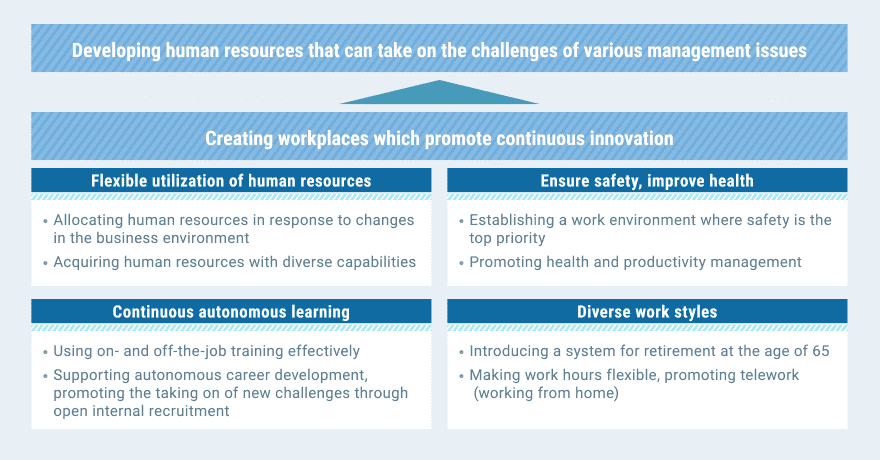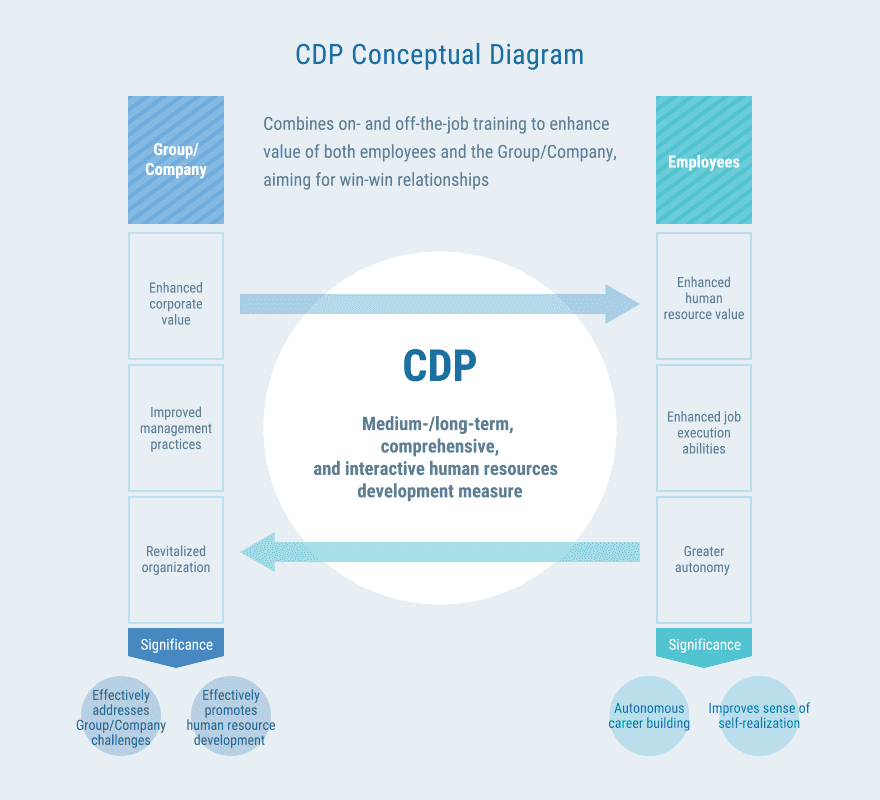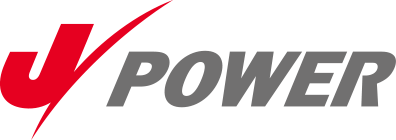- Home
- Sustainability
- Society
- J-POWER Group and Human Resources
J-POWER Group and Human Resources
The J-POWER Group is developing human resources that can take on the challenges of various management issues. The Group is doing that by supporting the autonomous growth of diverse human resources through the fostering of a culture in which employees can continue to learn regardless of age. By meeting the diverse needs of individual employees through the realization of flexible working styles and, at the same time, fully ensuring workplace safety and employee health, the Group is engaged in the creation of workplaces which promote continuous innovation and in which diverse human resources are motivated and flourish.

Recruiting and Making Effective Use of Human Resources
Approach to Human Resource Recruitment
The J-POWER Group’s approach is realizing stable recruiting in the interest of sustainable growth, seeking diverse human resources in a wide range of fields and age groups, and providing employees with opportunities to take an active part. In addition, we are engaged in creating systems and working environments that enable our diverse personnel to fully demonstrate their capabilities, without regard for gender, age, or other such distinctions.
Measures to Promote Diversity
J-POWER promotes women’s participation and advancement in the workplace.
Looking at the employment of older workers, since April 2021, the J-POWER Group has gradually begun raising its mandatory retirement age, and will ultimately extend it to the age of 65. In combination with our existing employment extension system; and the personnel registration system (available up to the end of the fiscal year in which an employee reaches the age of 70), which introduces job opportunities in the Group; the additional service of senior personnel possessing experience, skills, and motivation to work, will be harnessed in the sustained growth of our business.
We are enhancing working environments and promoting understanding among other employees through such initiatives as establishing a consultation desk where employees with disabilities can discuss employment assistance and working environments, as well as making office buildings barrier-free. We will continue making efforts to raise our employment rate of persons with disabilities. In addition, in order to build a workplace where diverse human resources can flourish, we aim to promote understanding of the basic philosophy of the J-POWER Group via level-specific training, human rights training, and other employee training.
Protection of Employees’ Rights
In accordance with the laws and regulations of each country in which we operate, the J-POWER Group protects the basic rights of its employees, including the prevention of child labor and forced labor, protection of the right to freedom of association, protection of the right to collective bargaining, and compliance with minimum wages. The Group also thoroughly prohibits discrimination in all its forms, including on the grounds of birth, nationality, race, creed, religion, gender, physical condition, and social status.
For operations in Japan, a labor union has been established with the aim of protecting the rights of workers and maintaining and improving their standard of living. Labor agreements are formed between the Company and the labor union, and the Company holds a conference on management policies with the labor union once a year to reflect the views of employees in management policies.
Human Resource Strategy and Management Strategy
The J-POWER Group’s human resource strategy is to support the autonomous growth of diverse personnel through the fostering of a culture in which employees can continue to learn regardless of age. By cultivating human resources that can resolutely take on the challenges of transforming themselves and the Group, we aim to encourage efforts to deal with management issues, and further management strategy from the personnel side.
Human Resource Development
Career Development Program
As a measure to develop human resources, the J-POWER Group has introduced a Career Development Program (CDP), promoting the cultivation of personnel who can take on the challenges of management issues with knowledge in multiple specialized areas and a broad perspective, developing all our employees into autonomous professionals.
Overview of the CDP
The CDP is based on personnel requirements, job rotation, and career building support systems. Through initiatives implemented from a number of angles via human resource development measures combining on- and off-the-job training, we aim to increase the value of both the Group and employees.

Personnel Requirements
The Group lays out the kinds of human resources that it needs as targets for its human resource development efforts, while employees use these targets as guideposts for their own career building and skill development efforts.
Job Rotation
The Group divides its employees’ careers into three broad stages: the basic knowledge and skill acquisition stage, the expert stage, and the professional stage. Job rotation helps employees gain the abilities necessary for each stage.
Career-Building Support Systems
To support employee’s independent career-building efforts, the Group systematically operates a range of support systems.
- Declaration System
Every year, employees make a declaration to the companies about their future career outlook, based in part on an examination of their execution of work duties and abilities. The employee’s manager discusses the declarations with the employee, offers advice as appropriate from a medium- to long-term human resource development perspective, and plans and implements employee rotations as needed.
- Training System
The Group implements training systems in step with each employee’s career stage, required skills, career path, and personal motivation. These include level-specific training and department-specific training1 as well as objective-specific training; self-improvement through distance or campus-based education; sending employees to study or work at universities or other institutions, including NGOs, in and outside Japan; and selective leadership training. In addition, through various open internal recruitment systems2, we support autonomous career building and taking on new challenges.
- 1.The technical departments (civil and architectural engineering; hydroelectric power; transmission and transformation; telecommunications; thermal power; and nuclear power) each have their own training facilities in order to systematically develop engineers
- 2.Open internal recruitment is used for sending employees to study or work at universities or other institutions in and outside Japan, participation in social issue-solving businesses in emerging countries, and in-house internships
Human resource development through such training programs is aimed not only at ensuring our human resources acquire the basic knowledge and skills necessary for our business, but also at fostering next-generation leaders, promoting diversity, and empowering our veteran employees.
- Support for CDP for Female Employees
We have a CDP for women by job type with the aim of enabling women to continue working and building careers even when life events, such as giving birth, temporarily restrict the work they can do. The CDP serves as a useful reference for female employees and their supervisors when thinking about career development.
- Support for Developing Junior Employees
To promote the development of junior employees and more active workplace communication, we appoint on-the-job trainers at workplaces for new hires and seek to thoroughly reinforce on-the-job training by involving entire workplaces, including more senior employees and supervisors, in employee development.
Evaluation and Management System
We have adopted an evaluation system that is based on a goal management system. The system encourages employees to perform work autonomously, heighten their drive to achieve, and improve their job execution abilities while working toward achieving their goals. We also set organizational goals with the aim of realizing organizational strategies through cooperation.
Employees set goals at the beginning of the fiscal year which they then work toward achieving. Meetings between employees and their supervisors are held at the beginning, middle, and end of the fiscal year to evaluate, respectively, the appropriateness of their goals, their progress toward them, and the final degree of achievement. These meetings also provide opportunities to give advice on how employees can reach their goals and to hear their workplace-related opinions and requests.
Example Human Resource Development Initiatives
Example International Department Initiatives
In developing and managing our overseas business, theJ-POWER Group holds joint training on topics such as internationallaw, taxes, finance, crisis management, compliance, andbusiness English for administrative and technical employees.
In addition, we provide on-the-job training in our overseasconsulting business for our technical employees, acquiringexpertise and technical capabilities through the design andsupervision of the construction of power plants and electricpower facilities overseas while at the same time utilizing theseas opportunities for human resource development.
Renewable Energy Department Example Initiatives
Consolidated subsidiary J-POWER HYTEC Co., Ltd., which operatesand provides maintenance for hydroelectric power plantsand wind farms, engages in cross-departmental humanresource exchanges.
Through such initiatives, the Company aims to develop humanresources through the acquisition of expertise and know-howfrom different departments.
Toward the Realization of Work-Life Balance and Improving Labor Productivity
Improving work-life balance promotes the creation of work environments and a culture that enable every employee to autonomously enhance their work and personal life and focus on highly creative work.
In addition, we have introduced policies to increase work efficiency as well as systems that support diverse work styles. This includes a revision to the ways in which meetings are held and a system for staggering working hours by up to two hours. We have implemented a telework system at Headquarters and other operating units, supporting flexible working styles while at the same time utilizing it as a system for responding to incidents such as natural disasters.
Whistleblower system (personnel and harassment issues related)
Aiming to create employee-friendly workplaces, we have established a consultation desk where employees can discuss work hours, the workplace environment, and harassment. The privacy of employees using this desk is assured. In order to prevent harassment, we have taken measures such as creating Group regulations and manuals, and we are implementing education for increased awareness via level-specific training courses, posters, and other such means. Further, we are training managers in each section on how to respond should a harassment- related incident occur as part of efforts to maintain a framework to respond to incidents appropriately.
